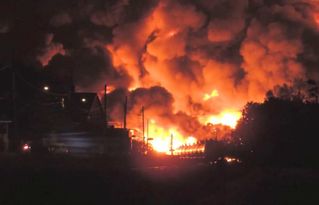JULY ACTION: STOP OIL TRAINS

Lac Megantic
oil train explosion
July 6 2013
The explosion killed 47 people, destroyed 44 buildings, and left 169 people homeless. Two years later survivors report that they are 4 times more likely to engage in excessive drinking and public health officials found that 50%of town residents are still suffering from depression and PTSD.
oil train explosion
July 6 2013
The explosion killed 47 people, destroyed 44 buildings, and left 169 people homeless. Two years later survivors report that they are 4 times more likely to engage in excessive drinking and public health officials found that 50%of town residents are still suffering from depression and PTSD.
OIL TRAINS POSE UNACCEPTABLE HAZARD
Between 2008 and 2013, the number of trains carrying crude oil in the US increased over 4,000%. The crude oil extracted from Bakken shale has a higher percentage of volatile organic compounds such as benzene, xylene, and toluene; a lower flash point, and a vapor pressure more than double that of non-shale crude.
Nearly 70% of the train tank cars carrying Bakken crude are recognized by the federal government to be inadequate and vulnerable to rupture, but new safety standards released this year allow unsafe tankers to remain in service for another decade.
The unprecedented increase in oil transport has led to a six fold increase in the number of oil spills from trains and the DOT predicts an average of 10 derailments per year between 2015 and 2030.
Our rail system was designed to serve urban centers and travels through densely populated areas. 25 million Americans live within the potential blast zone of an exploding oil train. A disproportionate number are Black and Latino. According to the DOT, a derailment near a population center could kill 200 people and cause $6 billion in damage.
Meanwhile, pressure is mounting in Congress to lift the ban on US oil exports, which would increase this dangerous practice and undermine the US contribution to global greenhouse gas reductions.
ACT
1) Check here to see if you, your patients, or your facility are in an oil train blast zone and to sign the petition to President Obama asking for stricter safety standards.
2) July 6-13 is annual STOP OIL TRAIN ACTION WEEK, in commemoration of the Lac Megantic disaster. Look here for local events to attend.
SHARE FaceBook and Twitter are in upper right corner of page
Between 2008 and 2013, the number of trains carrying crude oil in the US increased over 4,000%. The crude oil extracted from Bakken shale has a higher percentage of volatile organic compounds such as benzene, xylene, and toluene; a lower flash point, and a vapor pressure more than double that of non-shale crude.
Nearly 70% of the train tank cars carrying Bakken crude are recognized by the federal government to be inadequate and vulnerable to rupture, but new safety standards released this year allow unsafe tankers to remain in service for another decade.
The unprecedented increase in oil transport has led to a six fold increase in the number of oil spills from trains and the DOT predicts an average of 10 derailments per year between 2015 and 2030.
Our rail system was designed to serve urban centers and travels through densely populated areas. 25 million Americans live within the potential blast zone of an exploding oil train. A disproportionate number are Black and Latino. According to the DOT, a derailment near a population center could kill 200 people and cause $6 billion in damage.
Meanwhile, pressure is mounting in Congress to lift the ban on US oil exports, which would increase this dangerous practice and undermine the US contribution to global greenhouse gas reductions.
ACT
1) Check here to see if you, your patients, or your facility are in an oil train blast zone and to sign the petition to President Obama asking for stricter safety standards.
2) July 6-13 is annual STOP OIL TRAIN ACTION WEEK, in commemoration of the Lac Megantic disaster. Look here for local events to attend.
SHARE FaceBook and Twitter are in upper right corner of page
Proudly powered by Weebly